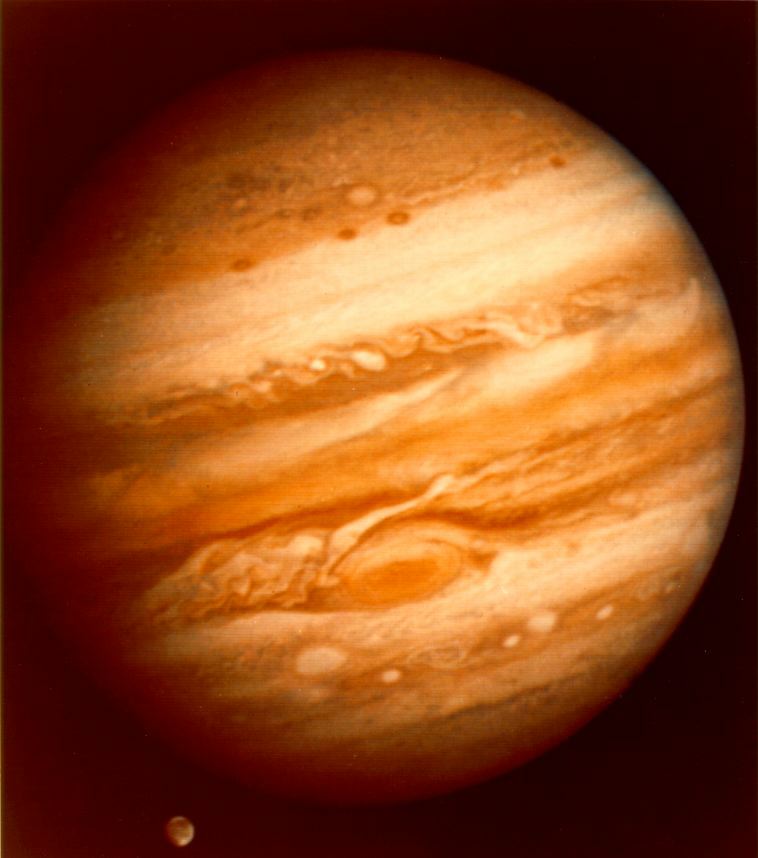
During the last class we discussed the terrestrial planets--that is those planets that are most like the Earth in size, composition, and structure. While the geologies of the inner four planets have some things in common, we have found that each one is quite different from the others. The next four planets we will talk about--Jupiter, Saturn, Uranus, and Neptune--are very different to the terrestrial planets in that they have no real solid surfaces, being dominated by thick, deep atmospheres. Thus, there is no "geology" to speak of, and we talk more about the meteorology (weather) of these gas giants.
Jupiter is the fifth planet from the Sun, and is the largest planet in the solar system. Its average distance from the Sun is 5.2 AU (778,330,000 km), and its equatorial radius is 68,700 km (almost 11 times that of Earth). Though Jupiter is very massive (having 318 times the mass of the Earth), it is not very dense: it has a mean density of 1.4 gm/cm3. Just slightly more dense than water! Suprisingly, even though Jupiter is enormous, it spins very rapidly, completing one rotation in slightly under 10 hours. It takes 12 years for Jupiter to circle the Sun. Jupiter is a swirling ball of clouds arranged in rotating storms and in complex bands:

These bands are caused by rising and descending air, as shown in Fig. 12.8 of the textbook:


Jupiter is mostly a large ball of hydrogen and helium gas with a few trace elements:

This picture illustrates the internal structure of Jupiter. The outer layer is primarily composed of molecular hydrogen. At greater depths the hydrogen starts resembling a liquid. At 10,000 kilometers below Jupiter's cloud top liquid hydrogen reaches a pressure of 1,000,000 bar with a temperature of 6,000° K. At this state hydrogen changes into a phase of liquid metallic hydrogen. In this state, the hydrogen atoms break down yielding ionized protons and electrons similar to the Sun's interior. Below this is a layer dominated by ice where "ice" denotes a soupy liquid mixture of water, methane, and ammonia under high temperatures and pressures. Finally at the center is a rocky or rocky-ice core of up to 10 Earth masses.1
The rapid rotation of Jupiter creates an incredible amount of shear in the atmosphere, and all kinds of storms form. The biggest of these, the "great red spot" was discovered by Cassini in the 17th century:
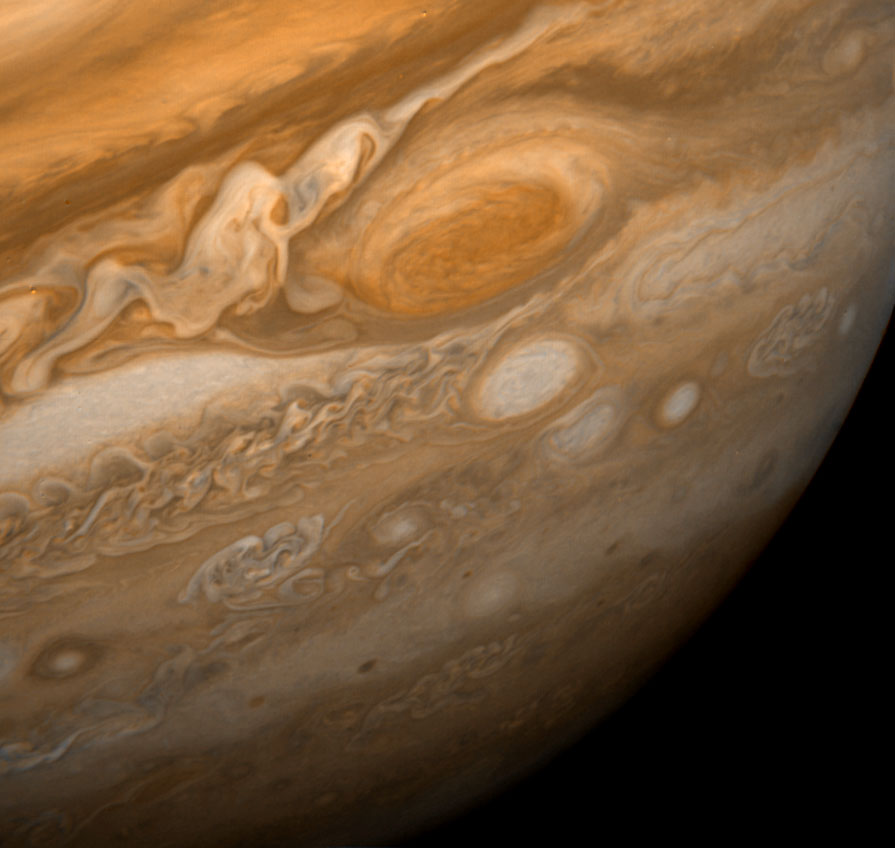
The red spot is simply a high pressure area like those seen on the Earth:
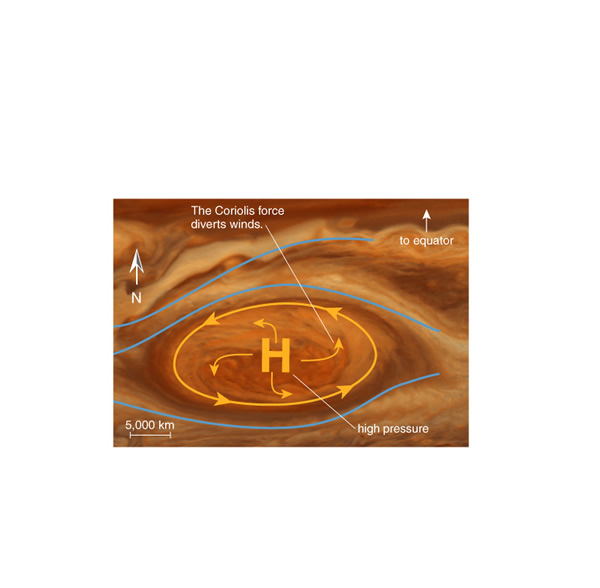
Jupiter has no real solid surface, with the clouds gradually compressing to a liquid state, and this further compresses into a "metallic" state that surrounds the rocky core. The temperature of Jupiter at the cloud tops is very cold, -121 C, but increases dramatically as you go inwards, reaching to 20,000 K in the core.
Jupiter has a large number of known moons (about 63 of them), but most of these are tiny little rocks (< 5 km in radii). There are four major moons of Jupiter: the "Galilean satellites" Io, Europa, Ganymede, and Callisto (shown in order, below--that tiny oblong rock to the left of Io is one of the smaller moons Almathea, that orbits inside that of Io).
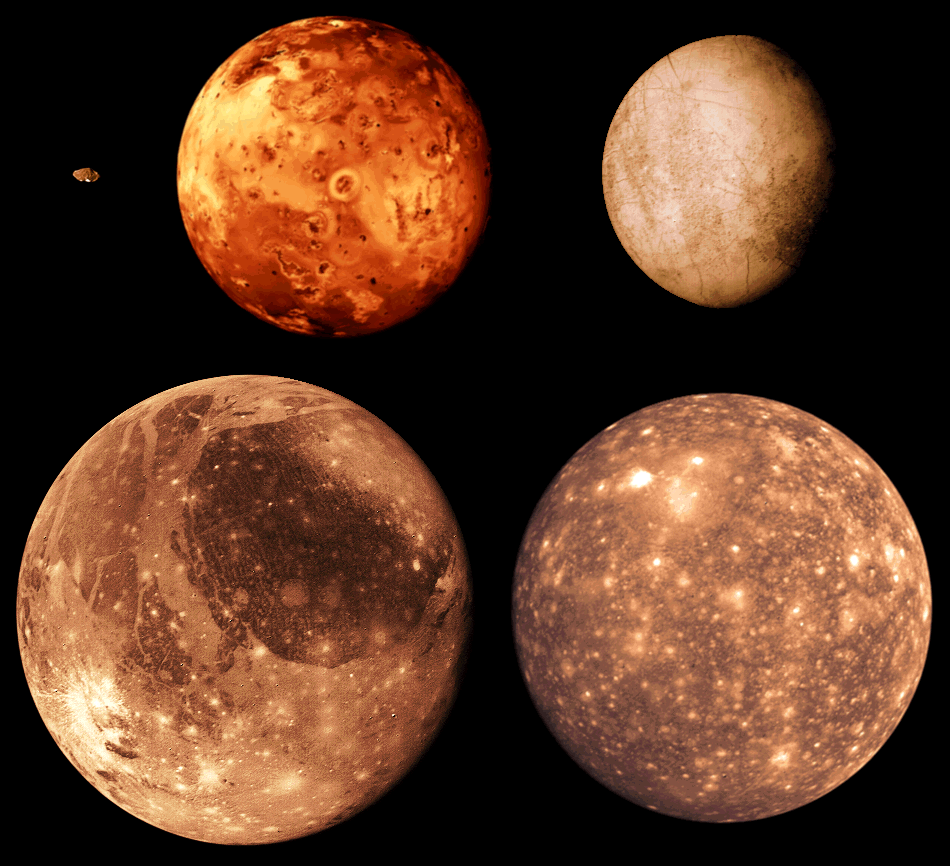
The innermost of these four moons is Io, and its surface is covered with lava flows from the numerous volcanoes on its surface (go to pages 347 and 348 of the textbook for more images).
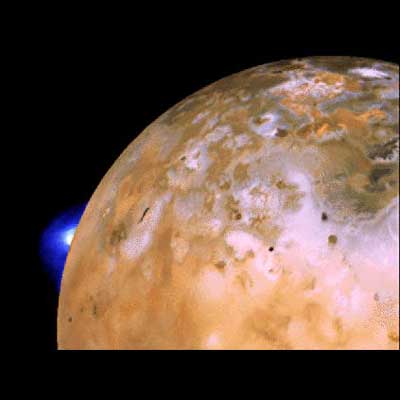
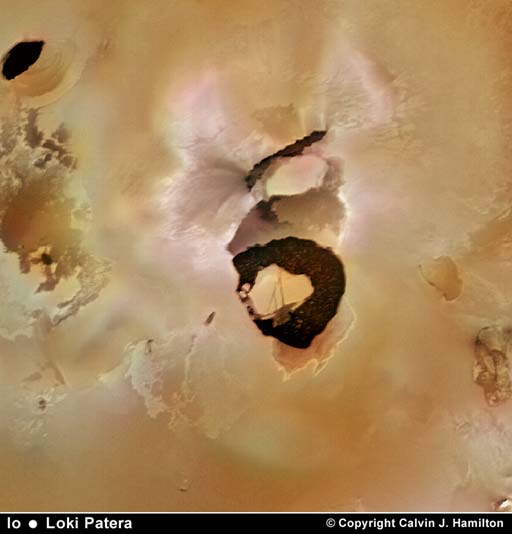

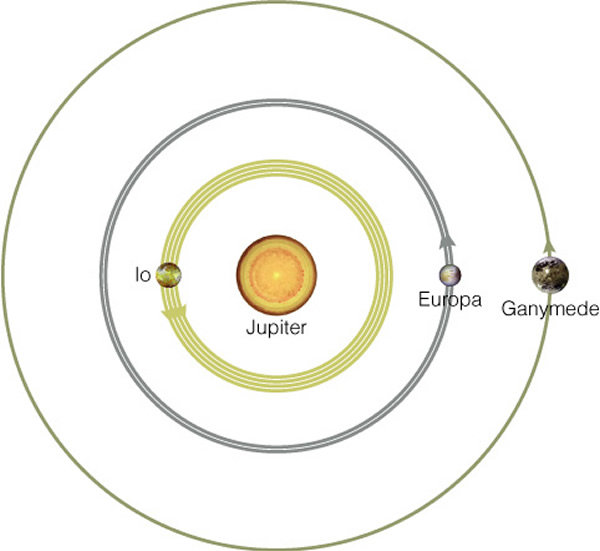
This generates an enormous amount of heat that liquifies the insides of Io. This process is also at work on the next moon out from Jupiter, Europa. Europa has one of the smoothest and brightest surfaces in the solar system. It is believed to be frozen water ice. Because ice is plastic (it flows), features with large elevations (mountains, craters, etc.) are not sustainable, and thus the surface is relatively smooth, but is covered with a large number of cracks:
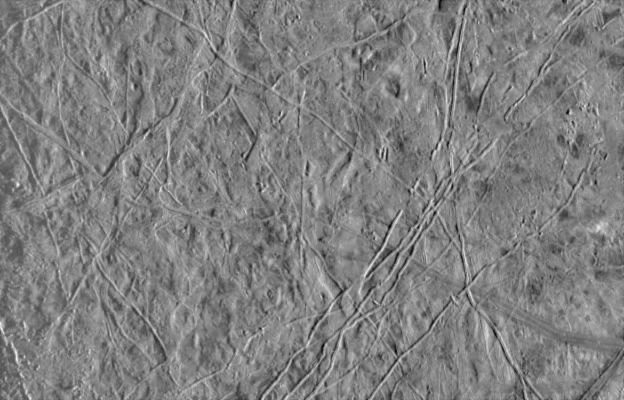
It is now believed that Europa has a large ocean of water beneath its frozen crust. This is also probably the case for the largest moon of Jupiter, Ganymede. Here are cutaway drawings of the internal structures of Jupiter's four moons (blue signifies water):
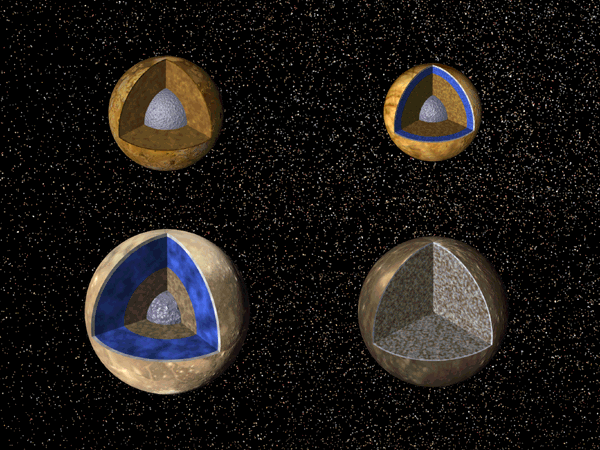
Here is a close-up of two possible models for Europa:
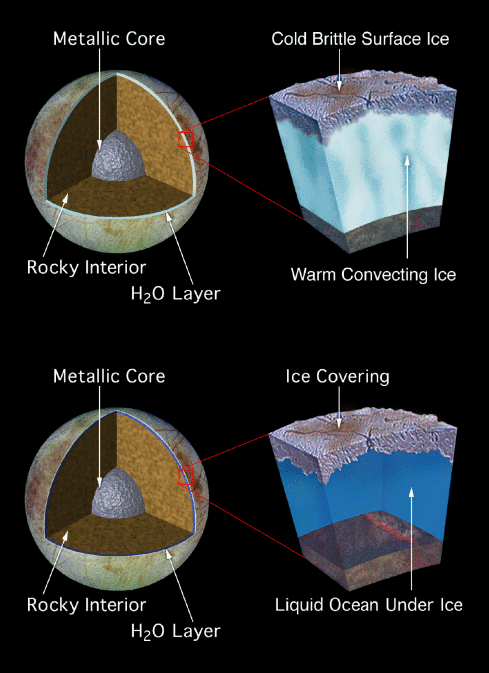
Plans are being drawn-up to explore Europa and/or Ganymede as they may be ideal sites for life to have evolved and to currently exist. For more on Europa, go here.
The largest planetary satellite in the solar system is Ganymede (radius of 2,600 km). It is mostly rock and ice, here are two close-ups:
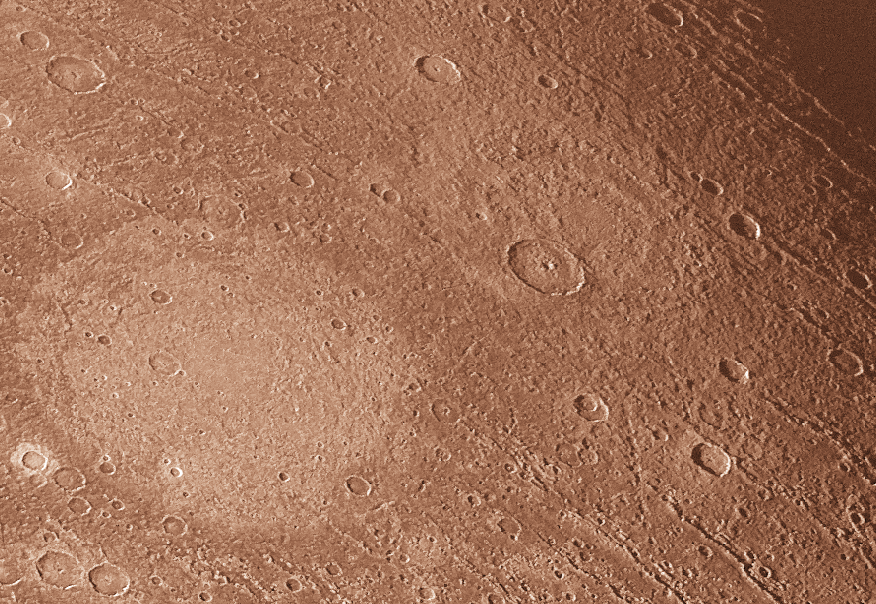
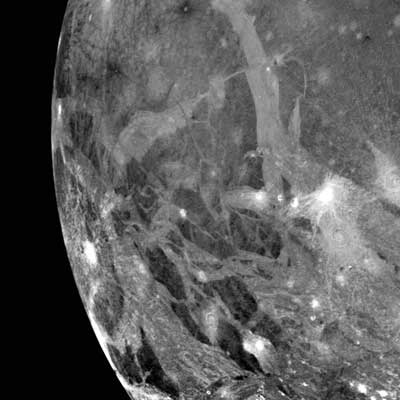
The final Gallilean satellite is Callisto, with a radius of 2400 km, it has one of the most battered surfaces of any object in the solar system:
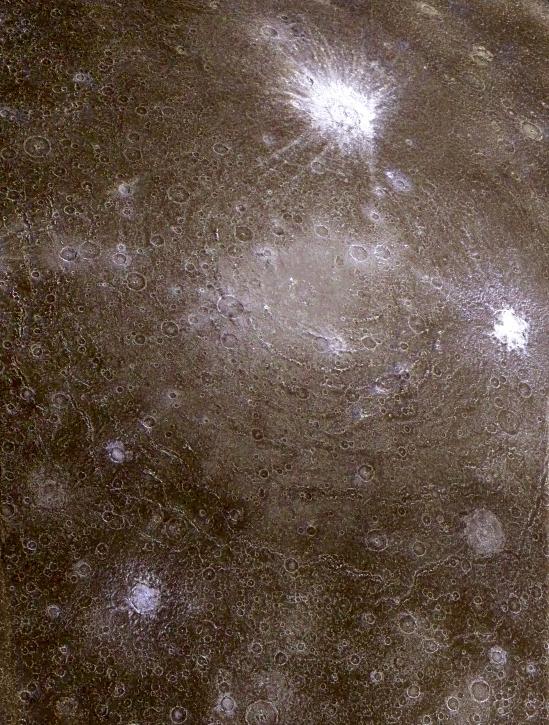
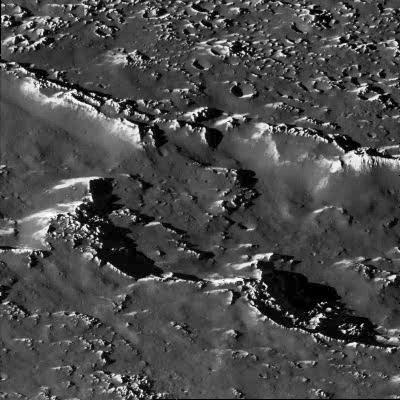
Saturn is the second largest planet in the solar system, with a radius of 60,268 km (9.45 times Earth), and orbits at an average distance of 9.54 AU (1,429,400,000 km) from the Sun, taking 29 years to complete one orbit. While Saturn is massive, equivalent to 95 Earth's, it has the lowest density of all of the planets: 0.71 gm/cm3, less than that of water! If Saturn was a solid object, and you had a big enough ocean, it would float. Saturn is certainly the most photogenic of all of the planets:
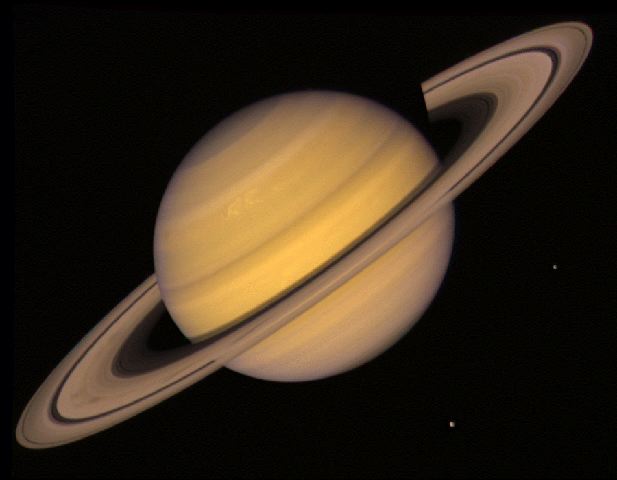
It also has storms and features like those seen on Jupiter:
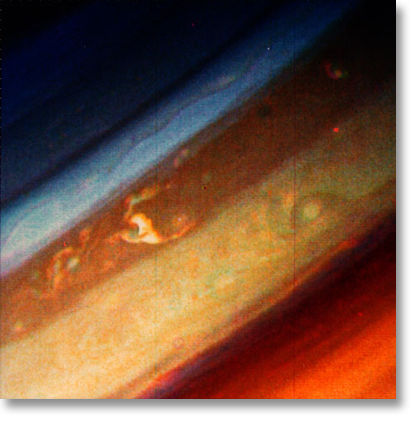
The ring system of Saturn is composed of many small boulders, rocks and dust from a disrupted moon. The rings themselves are about 250,000 km in diameter, but less than 1 km thick! The rings of Saturn are actually divided into innumerable smaller rings, as these close-ups show:
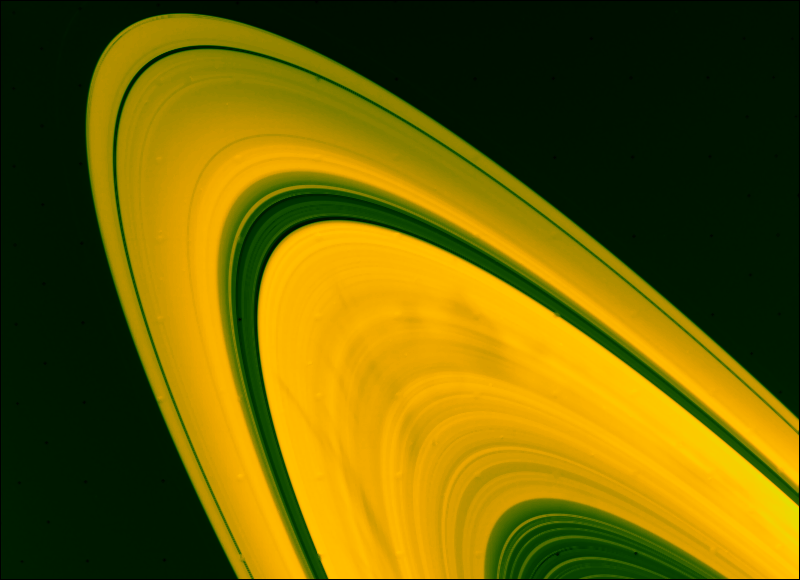
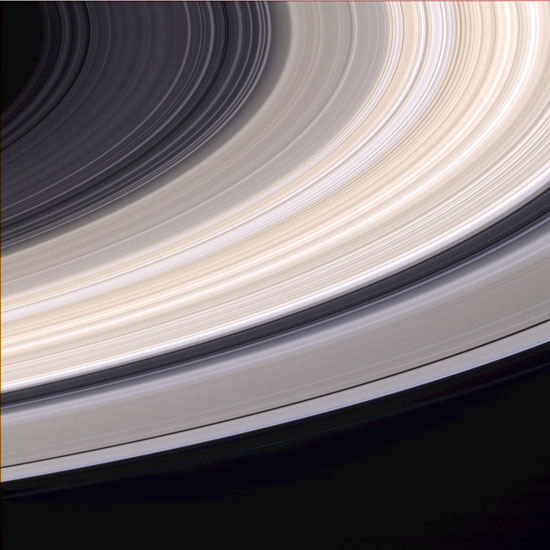
The reason for the division is that the small particles that orbit Saturn are tugged-on by the various moons of Saturn, and this creates orbital resonances, sweeping the region clear (see pages 359 and 360 of the textbook).
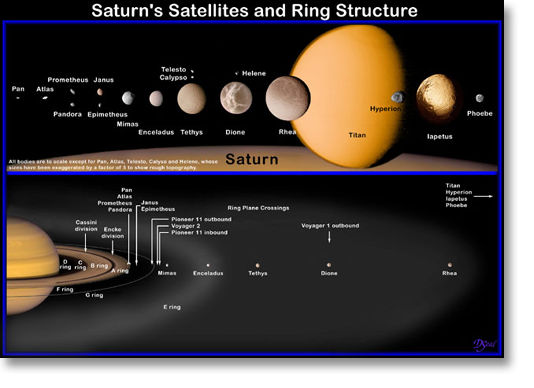
Like Jupiter, Saturn is a big ball of hydrogen and helium gas. At the very center, there may be a small rocky core. Outside of this core, however, is probably a weird high-pressure rock/ice mixture:
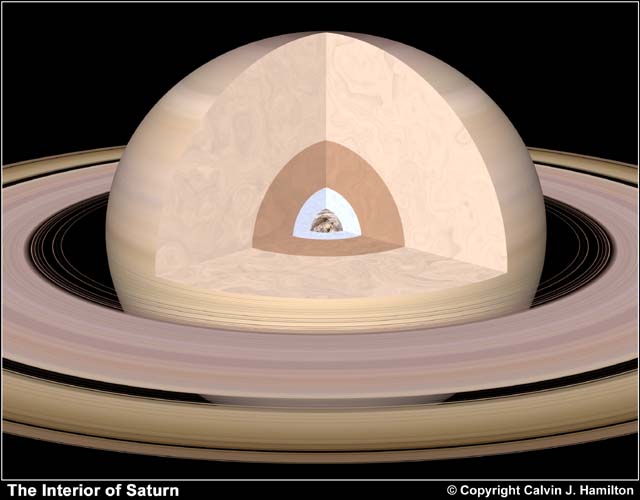
Saturn has 34 named moons, though the total is now up to 62! Most of them are small, but Saturn boasts the second largest (after Ganymede) moon in the solar system: Titan. Titan has a thick atmosphere that obscures the surface from view:
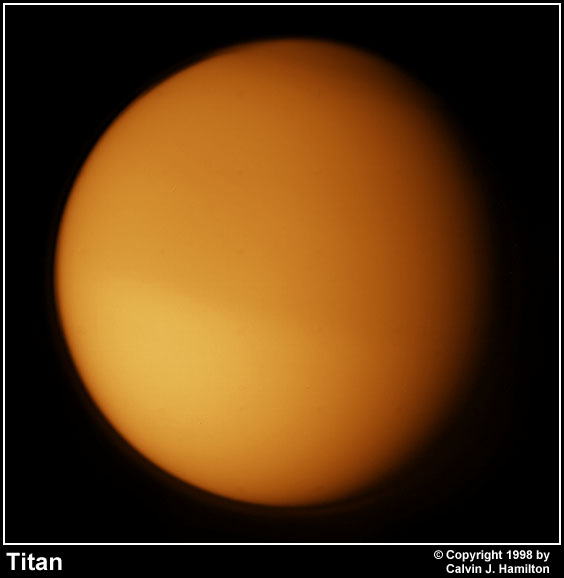
Titan is larger than Mercury (2,575 km in radius vs. 2,432 km), but much less massive since it only has a density of 2.2 gm/cm3. Titan's atmosphere seems to be mostly methane. At one time, many people thought that Titan might be a possible site for life. But recent discoveries have shown that the surface temperature is very low (-289oF), lower than previously expected (there was hope of an intense greenhouse effect). Recent near-infrared observations from the ground show surface features on Titan (and a bright white cloud):
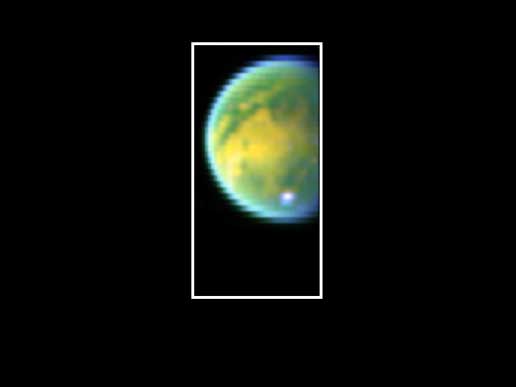
In January of 2005 the Huygens probe (of the Cassini mission) dropped into the atmosphere of Titan and parachuted down to the surface taking pictures and analyzing the composition of the atmosphere.
Huygens images:

A sinuous river-like feature on Titan (probably a methane = liquid natural gas river!).
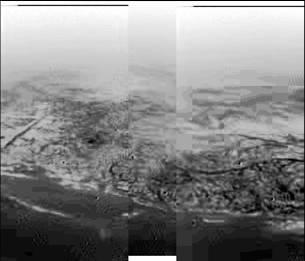
A cliff, or plateau region on Titan, with drainage features into a smoother region (a methane lake?). Note the lack of craters in these two images---Titan's surface is young.
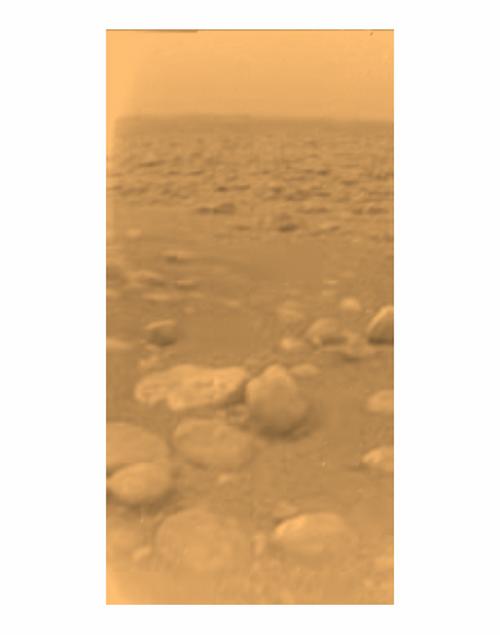
Blocks of (water?) ice on the surface of Titan.
Here is an image of one of the smaller moons of Saturn called Hyperion:
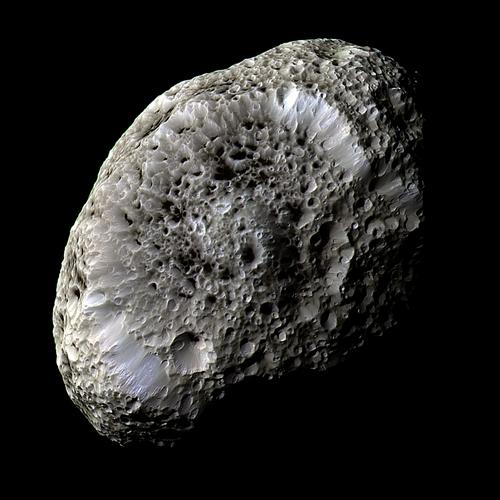
Water plumes/geysers on Enceladus:
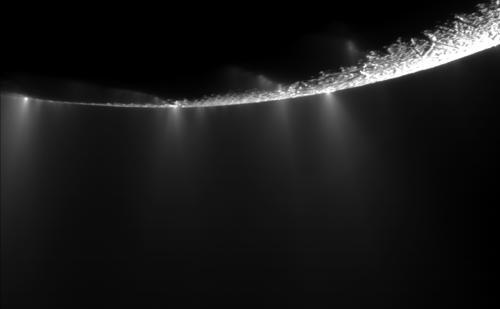
For more images from Saturn, go to the Cassini mission page.
Uranus has a radius of 25,500 km, and a mass of 14.5 Earth's. It has a density similar to Jupiter: 1.32 gm/cm3. It also spins rapidly, and has a "day" of 10 hours and 49 minutes. It orbits the Sun at an average distance of 19.2 AU (2.8 billion km), and takes 84 years to complete one trip around the Sun. Uranus is very strange in that its rotational axis lies very close to its orbital plane. This means that the seasons on Uranus are very long, with 21 years that have near constant daylight ("summer"), and 21 years of almost perpetual darkness ("winter").
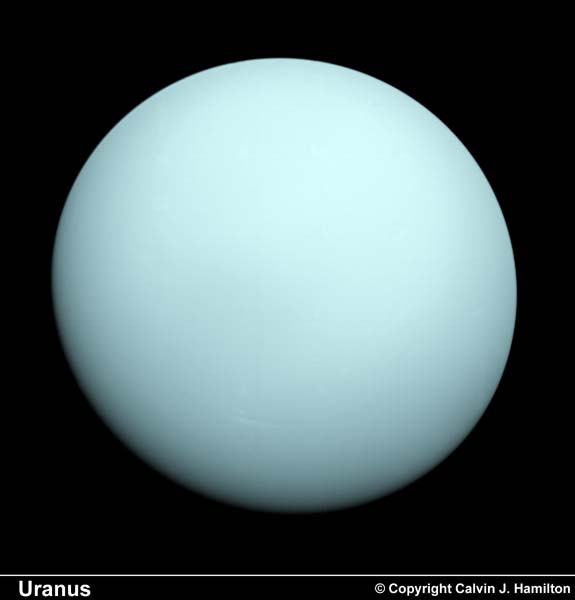
The disk of Uranus is almost completely featureless. There appears to be a high-altitude haze that blocks our view of the cloud deck. Saturn also has this haze layer, but it is not as thick as that of Uranus (Jupiter doesn't really have this structure). The cloud tops of Uranus are very cold, -200 C! Uranus has a structure similar to Jupiter and Saturn, a big ball of hydrogen and helium gas with a rocky core about equal to one Earth in size:
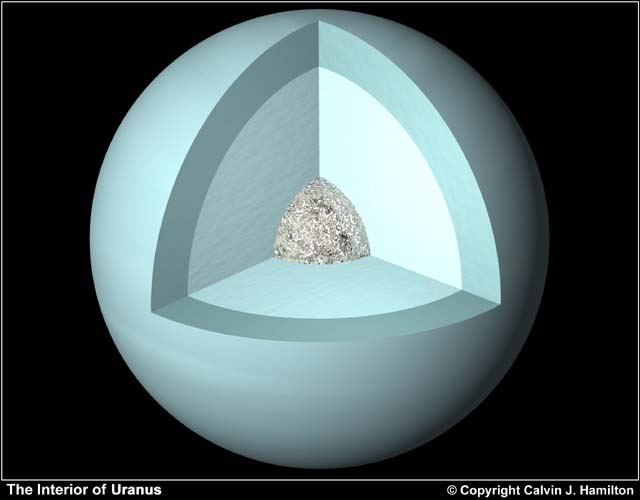
Like Saturn, Uranus has a ring system, but here the rings have much less material in them, and they are not quite as spectacular:

Uranus now has 21 named moons (and six unnamed moons), several of them quite interesting in their own rite, but none of them are very large (the largest, Oberon, has a radius of 761 km, for a comparison of the satellite systems of the Jovian planets, see the Figure 12.16 in the textbook also shown here:).
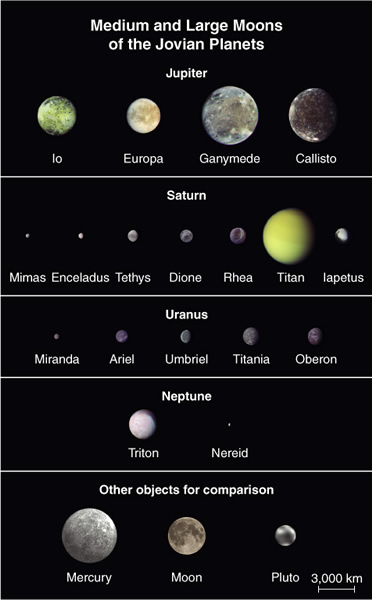
Neptune is much further from the Sun than Uranus (30 AU), and takes 165 years to complete one orbit. Neptune has 17.2 Earth masses, so it is more massive than Uranus. Note, however, that it is smaller in size than Uranus, having a radius of 24,700 km. Thus, it must have a higher density: 1.63 gm/cm3. Neptune also is the slowest rotating of the Jovian planets, with a rotation period of 16 hours. Strangely, Neptune's atmosphere appears to be much more active than that of Uranus (maybe the haze layer "freezes out" at this distance, where the cloud-top temperature is colder than that of Uranus), and has several large storms similar to those on Jupiter:
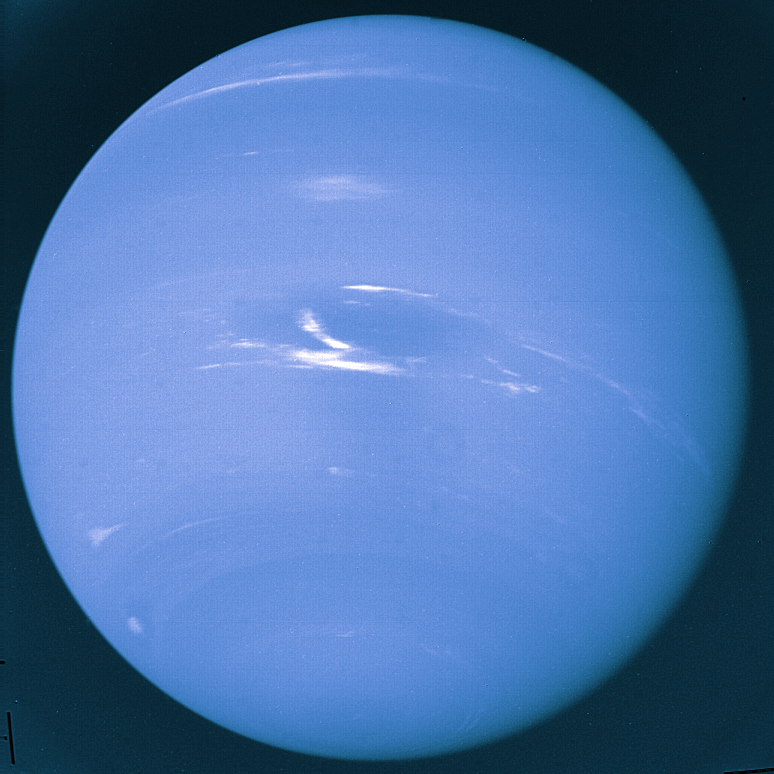
Neptune also has a very tenuous ring system like the other gas giants. Neptune has one very large moon (of the thirteen known) named Triton, that is 2,700 km in diameter:
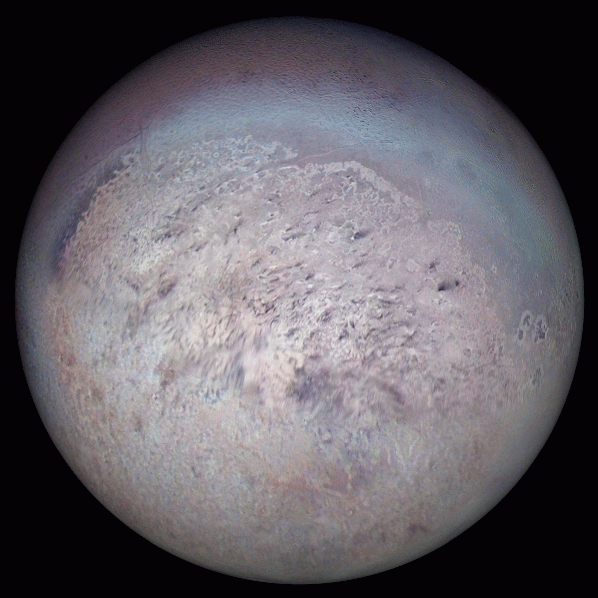
Triton has a tenuous atmosphere that is mostly composed of nitrogen. A surprising discovery were these black plumes seen in the photo below that appear to be liquid nitrogen geysers. The plumes seem to be blowing in a wind from the point of origin:
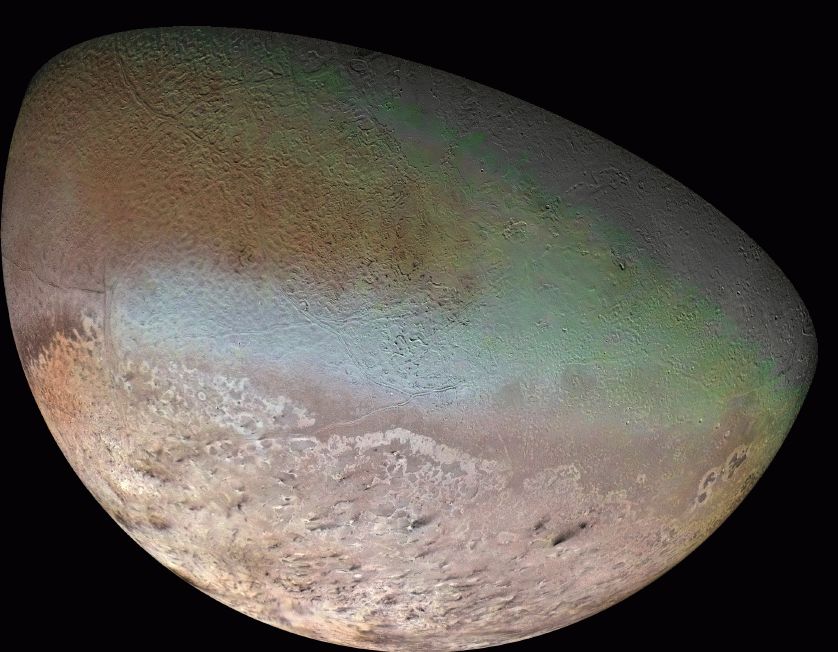
1From Jupiter